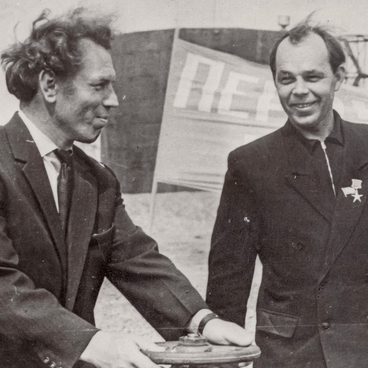The collection of the Uray City Historical Museum includes several unique folk dresses. They confirm the general idea that the clothes of the Northern peoples are usually very practical and adapted to local climatic conditions, economic activities and lifestyles.
This exhibit is a straight Mansi dress with numerous little folds on the chest. The person who sewed this dress made a stand-up collar and a front slit with ties.
Usually, monochrome fabrics were used to make dresses. The colors were mostly red and blue, sometimes black or crimson. The red fabric of this dress was decorated with a blue and white applique. The needlewoman also used yellow bands, although this color was not very popular with the Northern peoples in the decoration of dresses. The researchers noticed that in addition to yellow, the green color was practically never found in the traditional clothes of the Khanty and Mansi.
Tailoring was entirely women’s business. In the long winter evenings, they sewed clothes for the whole family. When making clothes, craftswomen endowed them with certain meanings, since each color served as a certain symbol. White symbolized snow, red — life, blue — rivers, water and the sky, rare yellow and green — fire and taiga, respectively.
According to the Mansi, the thoughts of a woman who was engaged in sewing clothes were sewn into seams and patterns. That is why a woman who was making clothes had to think only about the good things. The Mansi clothing was not considered ready until the decoration with local traditional patterns had been completed. Only then the clothes could be worn.
A variety of ornaments was used in decorating clothes. The main elements were a triangle, a square, a rhombus, a zigzag and a cross. They formed specific patterns, each of which had its own name. These are, for example, “hare ears”, “capercaillie”, “a brood of ducklings”, “squirrel track”, “rolling waves”, and “birch branch”. In addition, the clothes were decorated with beads. The Mansi believed that the beads on the collar, cuffs and hem protected from evil spirits.
This exhibit is a straight Mansi dress with numerous little folds on the chest. The person who sewed this dress made a stand-up collar and a front slit with ties.
Usually, monochrome fabrics were used to make dresses. The colors were mostly red and blue, sometimes black or crimson. The red fabric of this dress was decorated with a blue and white applique. The needlewoman also used yellow bands, although this color was not very popular with the Northern peoples in the decoration of dresses. The researchers noticed that in addition to yellow, the green color was practically never found in the traditional clothes of the Khanty and Mansi.
Tailoring was entirely women’s business. In the long winter evenings, they sewed clothes for the whole family. When making clothes, craftswomen endowed them with certain meanings, since each color served as a certain symbol. White symbolized snow, red — life, blue — rivers, water and the sky, rare yellow and green — fire and taiga, respectively.
According to the Mansi, the thoughts of a woman who was engaged in sewing clothes were sewn into seams and patterns. That is why a woman who was making clothes had to think only about the good things. The Mansi clothing was not considered ready until the decoration with local traditional patterns had been completed. Only then the clothes could be worn.
A variety of ornaments was used in decorating clothes. The main elements were a triangle, a square, a rhombus, a zigzag and a cross. They formed specific patterns, each of which had its own name. These are, for example, “hare ears”, “capercaillie”, “a brood of ducklings”, “squirrel track”, “rolling waves”, and “birch branch”. In addition, the clothes were decorated with beads. The Mansi believed that the beads on the collar, cuffs and hem protected from evil spirits.




